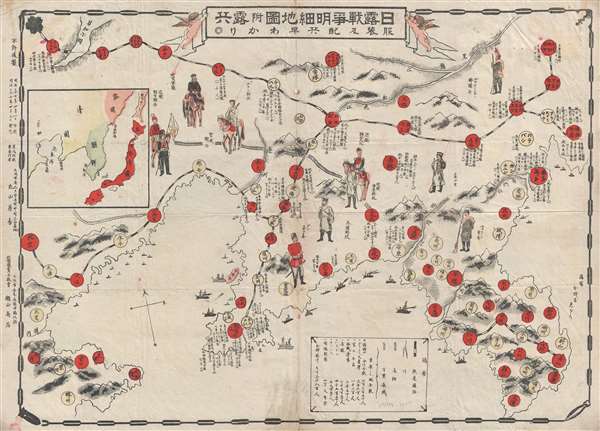This item has been sold, but you can get on the Waitlist to be notified if another example becomes available, or purchase a digital scan.
1904 Japanese Sugoroku Game Illustrating Russo-Japanese War (Korea, Manchuria)
RussoJapaneseWar-sugoroku-1904$200.00

Title
日露戰爭明細地圖 / Detailed Map of the Russo-Japanese War.
1904 (undated) 15 x 21 in (38.1 x 53.34 cm) 1 : 1152000
1904 (undated) 15 x 21 in (38.1 x 53.34 cm) 1 : 1152000
Description
An uncommon 1904 Meiji 37 Japanese map and Sugoroku game board drawn to illustrate the events and Russian military costumes from the Russo-Japanese War (1904 - 19045). The game board depicts from eastern China in the vicinity of Tianjin eastward to include parts of Manchuria, the Liaoning Peninsula (Dalian), Korean Peninsula, and eastern Shandong. Figures throughout represent Japanese, Korean, Chinese, and Russian military figures – some of which are on horseback.
There was initially some attempt at negotiation between the imperialist powers, but Tsar Nicholas II arrogantly believed it impossible that Japan could challenge a major European power. Japan proved him wrong, launching a surprise attack on the Russian Eastern Fleet stationed at Port Arthur. Throughout the course of the war, the Russians were defeated again and again, humiliating the Tsar and forcing U.S. President Theodore Roosevelt to arbitrate a peace, confirmed by the Treaty of Portsmouth. The treaty recognized Japan's claims on Korea and called for the evacuation of Russian forces from Manchuria, including from Port Arthur.
The overwhelming victory of Imperial Japan came as a surprise to international observers, being the first major military victory in the modern era of an Asian over European power. The consequences transformed the balance of power, confirmed Japan as the pre-eminent power in East Asia.
Sugoroku
The essence of the game, generally known as simplified sugoroku, is akin to the western board game, snakes and ladders. Historically there are two variants of sugoroku, one that is similar to backgammon, and the presently offered 'snakes and ladders' variant. This version of the game appeared as early as the 13th century, and was popularized by the rise of printing technology, especially in the Edo and Meiji periods, and subsequent availability of high-quality visually-arresting gameboards. Here players move along the railroad networks as they make their way to the finish. The game board here highlights Japan's military prowess, with battleships blockading the coast.Russo-Japanese War
The Russo-Japanese War, fought from February 8, 1904 - September 5, 1905, pitted Imperial Japan against Tsarist Russia over rival imperial ambitions in Manchuria and Korea. Both Russia and Japan had grand visions for the region. Russia traditionally had only one Pacific port, Vladivostok, which was operational only during the warm summer months. In 1898, Russia coerced China, then weakened after the First Sino-Japanese War (1894 - 1895), to lease Port Arthur, a warm water port on the Liaodang Peninsula. They also negotiated a right-of-way to connect Port Arthur to the China Eastern Railway, which ran from nearby Dalian (Dalny) to Harbin, a stop on the Siberian Railway. Russia, eager to expand southwards from Siberia, considered Port Arthur the cornerstone of a sphere of influence covering China, Manchuria, and Korea. Japan had its own Imperial ambitions and saw itself as the natural overlord in East Asia. Korea and Manchuria in particular were important as steppingstones into China, with its seemly unlimited resources.There was initially some attempt at negotiation between the imperialist powers, but Tsar Nicholas II arrogantly believed it impossible that Japan could challenge a major European power. Japan proved him wrong, launching a surprise attack on the Russian Eastern Fleet stationed at Port Arthur. Throughout the course of the war, the Russians were defeated again and again, humiliating the Tsar and forcing U.S. President Theodore Roosevelt to arbitrate a peace, confirmed by the Treaty of Portsmouth. The treaty recognized Japan's claims on Korea and called for the evacuation of Russian forces from Manchuria, including from Port Arthur.
The overwhelming victory of Imperial Japan came as a surprise to international observers, being the first major military victory in the modern era of an Asian over European power. The consequences transformed the balance of power, confirmed Japan as the pre-eminent power in East Asia.
Condition
Very good. Light soiling. Some wear on original folds.

